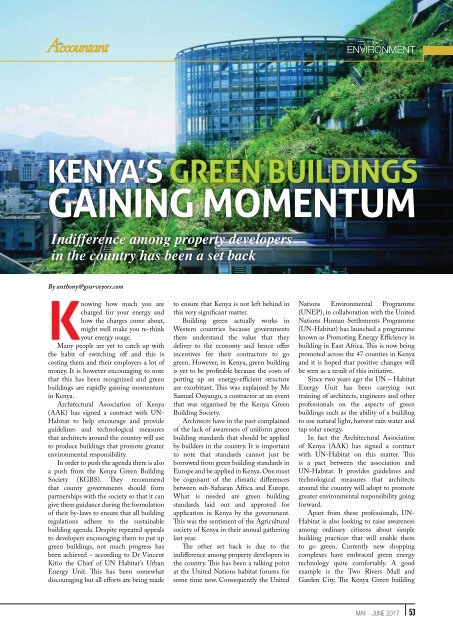The Accountant-May-June 2017
You also want an ePaper? Increase the reach of your titles
YUMPU automatically turns print PDFs into web optimized ePapers that Google loves.
ENVIRONMENT<br />
KENYA’S GREEN BUILDINGS<br />
GAINING MOMENTUM<br />
Indifference among property developers<br />
in the country has been a set back<br />
By anthony@gsurveyors.com<br />
Knowing how much you are<br />
charged for your energy and<br />
how the charges come about,<br />
might well make you re-think<br />
your energy usage.<br />
Many people are yet to catch up with<br />
the habit of switching off and this is<br />
costing them and their employers a lot of<br />
money. It is however encouraging to note<br />
that this has been recognized and green<br />
buildings are rapidly gaining momentum<br />
in Kenya.<br />
Architectural Association of Kenya<br />
(AAK) has signed a contract with UN-<br />
Habitat to help encourage and provide<br />
guidelines and technological measures<br />
that architects around the country will use<br />
to produce buildings that promote greater<br />
environmental responsibility.<br />
In order to push the agenda there is also<br />
a push from the Kenya Green Building<br />
Society (KGBS). <strong>The</strong>y recommend<br />
that county governments should form<br />
partnerships with the society so that it can<br />
give them guidance during the formulation<br />
of their by-laws to ensure that all building<br />
regulations adhere to the sustainable<br />
building agenda. Despite repeated appeals<br />
to developers encouraging them to put up<br />
green buildings, not much progress has<br />
been achieved – according to Dr Vincent<br />
Kitio the Chief of UN Habitat’s Urban<br />
Energy Unit. This has been somewhat<br />
discouraging but all efforts are being made<br />
to ensure that Kenya is not left behind in<br />
this very significant matter.<br />
Building green actually works in<br />
Western countries because governments<br />
there understand the value that they<br />
deliver to the economy and hence offer<br />
incentives for their contractors to go<br />
green. However, in Kenya, green building<br />
is yet to be profitable because the costs of<br />
putting up an energy-efficient structure<br />
are exorbitant. This was explained by Mr<br />
Samuel Onyango, a contractor at an event<br />
that was organised by the Kenya Green<br />
Building Society.<br />
Architects have in the past complained<br />
of the lack of awareness of uniform green<br />
building standards that should be applied<br />
by builders in the country. It is important<br />
to note that standards cannot just be<br />
borrowed from green building standards in<br />
Europe and be applied in Kenya. One must<br />
be cognisant of the climatic differences<br />
between sub-Saharan Africa and Europe.<br />
What is needed are green building<br />
standards laid out and approved for<br />
application in Kenya by the government.<br />
This was the sentiment of the Agricultural<br />
society of Kenya in their annual gathering<br />
last year.<br />
<strong>The</strong> other set back is due to the<br />
indifference among property developers in<br />
the country. This has been a talking point<br />
at the United Nations habitat forums for<br />
some time now. Consequently the United<br />
Nations Environmental Programme<br />
(UNEP), in collaboration with the United<br />
Nations Human Settlements Programme<br />
(UN-Habitat) has launched a programme<br />
known as Promoting Energy Efficiency in<br />
building in East Africa. This is now being<br />
promoted across the 47 counties in Kenya<br />
and it is hoped that positive changes will<br />
be seen as a result of this initiative.<br />
Since two years ago the UN – Habitat<br />
Energy Unit has been carrying out<br />
training of architects, engineers and other<br />
professionals on the aspects of green<br />
buildings such as the ability of a building<br />
to use natural light, harvest rain water and<br />
tap solar energy.<br />
In fact the Architectural Association<br />
of Kenya (AAK) has signed a contract<br />
with UN-Habitat on this matter. This<br />
is a pact between the association and<br />
UN-Habitat. It provides guidelines and<br />
technological measures that architects<br />
around the country will adopt to promote<br />
greater environmental responsibility going<br />
forward.<br />
Apart from these professionals, UN-<br />
Habitat is also looking to raise awareness<br />
among ordinary citizens about simple<br />
building practices that will enable them<br />
to go green. Currently new shopping<br />
complexes have embraced green energy<br />
technology quite comfortably. A good<br />
example is the Two Rivers Mall and<br />
Garden City. <strong>The</strong> Kenya Green building<br />
MAY - JUNE <strong>2017</strong> 53

















